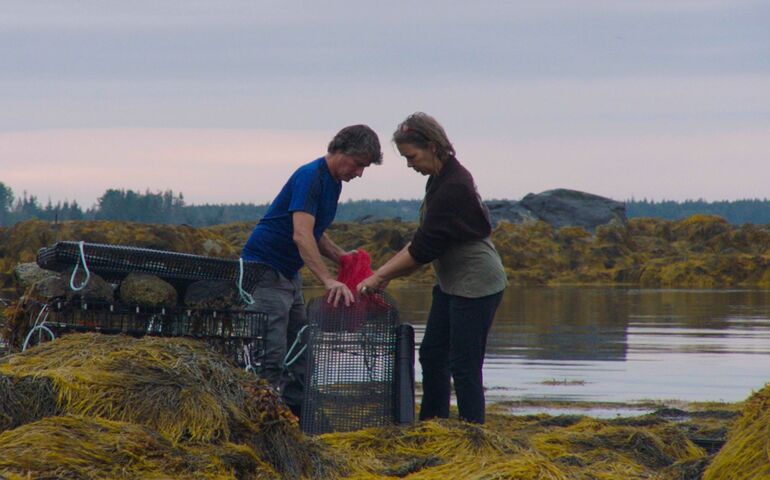Go-to-market guide aims to help seafood farmers navigate supply chain challenges
 Courtesy / Maine Aquaculture Association, GoodFight Media
A new go-to-market guide aims to help seafood farmers navigate supply chain challenges. Here, Toni Small and her partner John Cotton work on their oyster farm in Port Clyde.
Courtesy / Maine Aquaculture Association, GoodFight Media
A new go-to-market guide aims to help seafood farmers navigate supply chain challenges. Here, Toni Small and her partner John Cotton work on their oyster farm in Port Clyde.
The Maine Aquaculture Association on Tuesday released a guide designed to help seafood farmers evaluate distribution channels for their products to best decide how to get them to market.
The Maine Aquaculture Distribution Mapping Manual was developed in response to new distribution methods that have emerged over the past two years, including direct-to-consumer sales that have gained in popularity and now serve as an important channel, according to a news release.
“As Maine’s working waterfront continues to face new supply chain challenges, the industry and consumer demand keeps growing,” Sebastian Belle, the association’s executive director, said in the release. “By nature, Maine’s farm fishing families are open to navigating choppy waters when they need to. It’s our collective responsibility to support their efforts to bring their product to market.”
For the full report, click here.
Seafood sales climb
Maine’s aquaculture industry represents nearly 200 farms and more than 700 farmers who produce premium seafood including fin fish, shellfish and sea vegetables. The sector has been steadily growing in recent years, and its total economic impact has nearly tripled — from $50 million in 2007 to $137 million in 2014 — according to the latest Maine Aquaculture Economic Impact Report.
Across the nation, retail seafood sales were up 35% to $7 billion in 2020 compared to 2019, according to market research company Information Resources Inc.
With roughly 80% of all seafood consumed in restaurants nationally, Maine aquaculture producers lost significant markets during the early days of the pandemic as restaurants closed their doors.
Distribution changes
More than 20 stakeholders were interviewed to inform the manual, including seafood producers, wholesalers, distributors, restaurateurs, trucking companies and other aquaculture industry members, both in Maine and across the U.S.
The manual, funded in partnership with FocusMaine, puts forth three main recommendations to farmers:
- Diversify sales channels
- Maintain strong relationships
- Keep product quality consistent.
“When the pandemic hit, our distribution chain changed, probably forever,” said Owen Heil, owner of Pound of Tea Oysters and Spartan Sea Farms in Freeport. “We need to be informed about how to navigate shifts in the market to stay in business.”
Heil and his partner Ken Sparta relied on local deliveries to sell their freshly harvested kelp and oysters when the pandemic hit in the spring of 2020.
“From online sales to pop-ups and farmer’s markets, there are many routes to distribution,” said Toni Small of Ice House Oysters in Port Clyde.
Small said the manual helps seafood farmers understand the benefits and risks distribution channels.
The mapping manual should also help inform a collaborative project underway among the association, the University of Maine School of Economics, Gulf of Maine Research Institute, Island Institute and University of Maine Cooperative Extension. The project, funded via NOAA and Maine Sea Grant, explores in greater detail the costs, volumes, availability and reach of the identified distribution channels, along with consumer preferences for Maine seafood across the U.S.
In January, the association and Maine Sea Grant, on behalf of the Maine Aquaculture Hub, released the Maine Aquaculture Roadmap 2022-32, a 10-year plan that proposes four major goals and identifies over $15 million in estimated resources needed to strengthen Maine’s aquaculture sector and working waterfronts.










0 Comments